A Month with Apple's Fusion Drive
by Anand Lal Shimpi on January 18, 2013 9:30 AM EST- Posted in
- Storage
- Mac
- SSDs
- Apple
- SSD Caching
- Fusion Drive
Fusion Drive: Under the Hood
I took the 27-inch iMac out of the box and immediately went to work on Fusion Drive testing. I started filling the drive with a 128KB sequential write pass (queue depth of 1). Using iStat Menus 4 to actively monitor the state of both drives I noticed that only the SSD was receiving this initial write pass. The SSD was being written to at 322MB/s with no activity on the HDD.
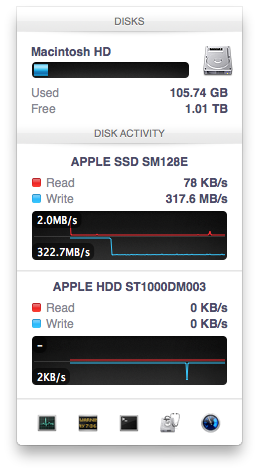
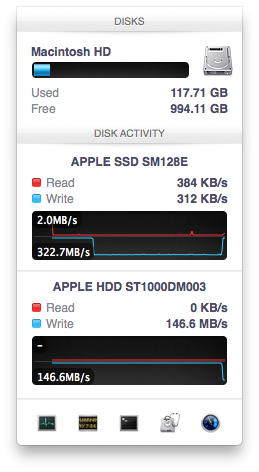
After 117GB of writes the HDD took over, at speeds of roughly 133 - 175MB/s to begin with.
The initial test just confirmed that Fusion Drive is indeed spanning the capacity of both drives. The first 117GB ended up on the SSD and the remaining 1TB of writes went directly to the HDD. It also gave me the first indication of priority: Fusion Drive will try to write to the SSD first, assuming there's sufficient free space (more on this later).
Next up, I wanted to test random IO as this is ultimately where SSDs trump hard drives in performance and typically where SSD caching or hybrid hard drives fall short. I first tried the worst case scenario, a random write test that would span all logical block addresses. Given that the total capacity of the Fusion Drive is 1.1TB, how this test was handled would tell me a lot about how Apple maps LBAs (Logical Block Addresses) between the two drives.
The results were interesting and not unexpected. Both the SSD and HDD saw write activity, with more IOs obviously hitting the hard drive (which consumes a larger percentage of all available LBAs). The average 4KB (QD16) random write performance was around 0.51MB/s, it was constrained by the hard drive portion of the Fusion Drive setup.
After stopping the random write task however, there was immediate moving of data between the HDD and SSD. Since the LBAs were chosen at random, it's possible that some (identical or just spatially similar) addresses were picked more than once and those blocks were immediately marked for promotion to the SSD. This was my first experience with the Fusion Drive actively moving data between drives.
A full span random write test is a bit unfair for a consumer SSD, much less a hybrid SSD/HDD setup with roughly an 1:8 ratio of LBAs. To get an idea of how good Fusion Drive is at dealing with random IO I constrained the random write test to the first 8GB of LBAs.
The resulting performance was quite different. For the first pass, average performance was roughly 7 - 9MB/s, with most of the IO hitting the SSD and a smaller portion hitting the hard drive. After the 3 minute test, I waited while the Fusion Drive moved data around, then repeated it. For the second run, total performance jumped up to 21.9MB/s with more of the IO being moved to the SSD although the hard drive was still seeing writes.
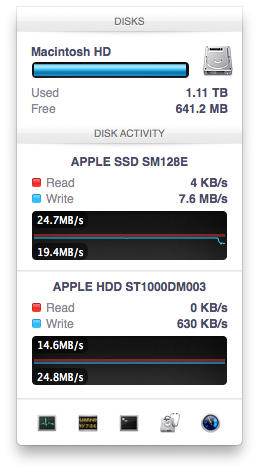
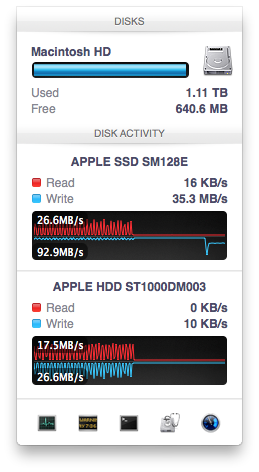
In the shot to the left, most random writes are hitting the SSD but some are still going to the HDD, after some moving of data and remapping of LBAs nearly all random writes go to the SSD and performance is much higher
On the third attempt, nearly all random writes went to the SSD with performance peaking at 98MB/s and dropping to a minimum of 35MB/s as the SSD got more fragmented. This told me that Apple seems to dynamically map LBAs to the SSD based on frequency of access, a very pro-active approach to ensuring high performance. Ultimately this is a big difference between standard SSD caches and what Fusion Drive appears to be doing. Most SSD caches seem to work based on frequency of read access, whereas Fusion Drive appears to (at least partially) take into account what LBAs are frequently targeted for writes and mapping those to the SSD.
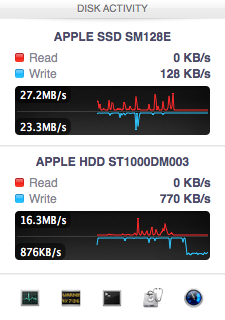
Note that subsequent random write tests produced very different results. As I filled up the Fusion Drive with more data and applications (~80% full of real data and applications), I never saw random write performance reach these levels again. After each run I'd see short periods where data would move around, but random IO hit the Fusion Drive in around an 7:1 ratio of HDD to SSD accesses. Given the capacity difference between the drives, this ratio makes a lot of sense. If you have a workload that is composed of a lot of random writes that span all available space, Fusion Drive isn't for you. Given that most such workloads are confined to the enterprise space, that shouldn't really be a concern here.










127 Comments
View All Comments
name99 - Friday, January 18, 2013 - link
Yeah, and USING Momentus XT sucks. The experience is horribly uneven.Enough stuff comes up fast that you get used to that, but enough stuff comes up slowly that it's REALLY noticeable because you're used to the occasional bursts of speed.
I've used Momentus, I've used Fusion. There is no comparison.
In fact (true story) after I replaced the broken HD in a friend's MacBook Pro with a Momentus she told me a week later that she thought the computer was still broken because it seemed to behave so strangely, sometimes feeling really fast, then a little later feeling so slow.
Now, if Momentus were kitted out with
- 64GB (maybe even just 32GB) of
- FAST flash (not the cheap crap used in USB thumb drives) AND
- cached writes
it might work well. But that's not the product that Seagate is selling.
Death666Angel - Friday, January 18, 2013 - link
2 of your 3 points are very correct. But they do use SLC which is not the cheap stuff.name99 - Friday, January 18, 2013 - link
If they do use decent flash, then why don't they cache writes?I always assumed it was because their flash (like USB thumb flash) was so crappy that it was slower for random writes than the HD was.
kyuu - Saturday, January 19, 2013 - link
Because there's a lot more to it than just using the right NAND. Also, for the 2nd-gen Momentus XT they were going to release a firmware update that would enable write caching. I'm not sure if that ever happened, haven't followed up on it recently.kyuu - Saturday, January 19, 2013 - link
That's because the MacBook/MacOS sucks. Not the Momentus XT's fault.Been using a Momentus XT in a Windows machine for a long time, had no problems with it being "uneven".
Also, they sure as hell don't use cheap flash "used in USB thumb drives".
ShieTar - Saturday, January 19, 2013 - link
How would the HDD know what is a file? The OS will just command a drive to write a given data block to Sector X.The drive may treat X as a logical address, and reorder data internally, but it has no clue if it is writing a complete file or parts of it, or just writing zeros as ordered by some secure erase software.
Subyman - Friday, January 18, 2013 - link
Any word on how much the migration process increases read/write quantity over a manually managed setup? As for ssd life being longer than hdd life, if we take into account that almost all writes will hit the ssd first and then some will transfer to the hdd this means the hdd is accessed less often. This could level the mean read/write to failure rate to make the hdd even with the ssd, unless migration has an effect that I'm not considering.dimmer - Friday, January 18, 2013 - link
Did you enable TRIM or not?name99 - Friday, January 18, 2013 - link
It's a Mac for gods sake. It comes configured correctly (yes, with TRIM enabled) out the box.alanh - Friday, January 18, 2013 - link
For me, the biggest problem is the added difficulty of doing an upgrade or replacement of storage if it starts getting full or goes bad. From what I've read, the only option is to do a full backup, replace one of the disks, and then do a full restore. I have an '11 MBP with SSD and the DVD replaced with a large HD, so I could, in theory move to a Fusion drive, but it just seems like a risky and annoying proposition.